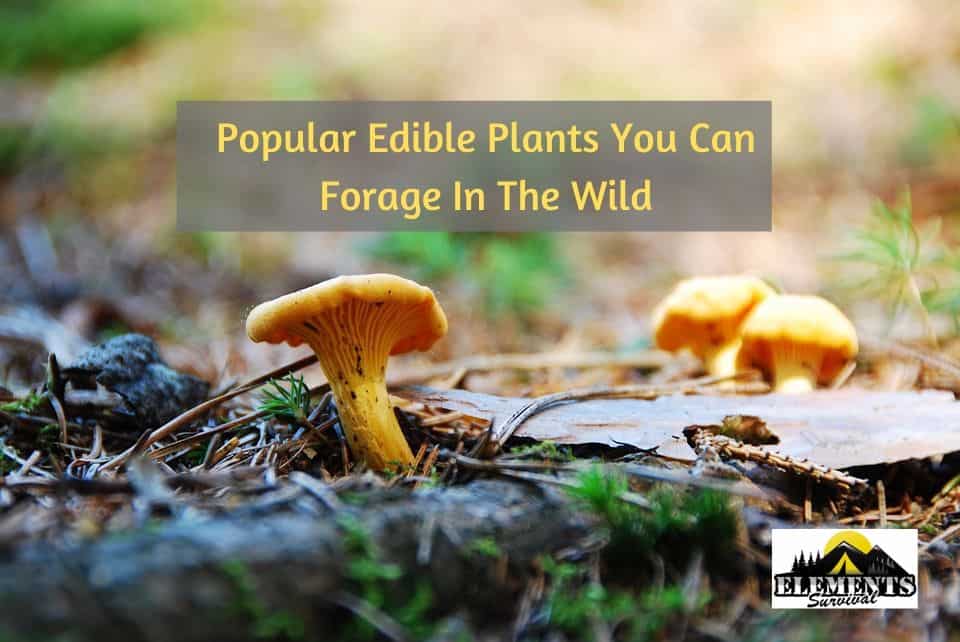The earliest human beings were hunter-gatherers and obtained food by foraging — hunting wild animals and collecting wild plants. These people lived nomadic lifestyles and moved from place to place looking for food.
Through centuries of practice, they learned to recognize which types of plants, berries, and fungus were edible, which were poisonous, and which only grew during certain seasons.
These days, things are much simpler. Most of our food is grown is huge farms away from cities. All you need to do is to take a trip to the nearest Wal-Mart if you want to gather food.
We don’t have to tend to the plants we eventually eat or see them growing in front of our eyes. We lack the appreciation and personal connections to our food that our ancestors had. However, it doesn’t always have to be this way.
Even in today’s modern times, it is possible to reestablish our severed connection to nature. It is a good idea to go out in the woods from time to time and pick wild plants straight off the ground that are highly nutritious and organic.
However, as we do not have the intrinsic knowledge of our ancestors that could differentiate between edible and non-edible plants, simply wandering unawares into a field and chomping on any interesting looking plant could be a recipe for disaster.
Foraging for Edible Plants Safely
It can take years to learn to identify the plants that can be eaten, and more importantly, those that shouldn’t be eaten.
If you are a beginner, the best advice you can follow is never to eat anything that you cannot definitely identify. If you don’t know what it is, don’t eat it. This part can be very tricky since many types of flora look quite similar, but one may be edible while the other is not. Some greens, berries, and fungus may look like they are the best plants to eat, but they can leave you with a bad stomachache — and can even be toxic in some cases.
Some plants contain cyanide, a deadly poison that can kill instantly, even if taken in minute quantities. If a plant smells like bitter almonds, don’t ever eat it, as it contains cyanide.
Before venturing out into a forest on your own, you should take a crash course for survival skills with local experts who know about the area. When venturing into new territory with unfamiliar plants, find out what the indigenous people eat, as they are your best guide on which plants are edible.
Another suggestion is to eat a small part of a plant and wait for an adverse reaction, although this is not generally advisable as some plants can be deadly. If you feel any adverse reaction, induce vomiting immediately and drink plenty of water.
Beware of plants that grow alongside roads, as they may be contaminated with harmful chemicals.
Having said that, eating edible wild food is very good for you, and there are dozens of wild varieties that people with beginner survival skills can identify and gather. To help you get started, we have selected a few common edible plants that are known for their nutrition, medicinal properties, and abundance.
Wild Garlic

Wild garlic has a milder taste than the cultivated variety. It can be identified because of its distinctive garlicky smell and is found spread out like green carpets near bluebells in woodlands. Wild garlic can also treat high blood pressure and reduce cholesterol levels.
Seaweed
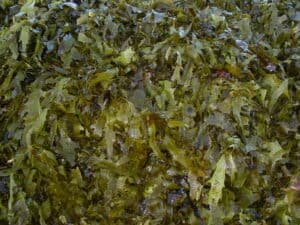
Seaweed, one of the favorite ingredients in Japanese cuisine, is chock-full of vitamins and minerals. You can collect seaweed from any coastline with exposed rocks. The best time for seaweed foraging is when the tide is low, which exposes the wide range of varieties. Seaweed can reduce cholesterol levels, manage skin conditions and help improve blood circulation and thyroid levels.
Dandelion
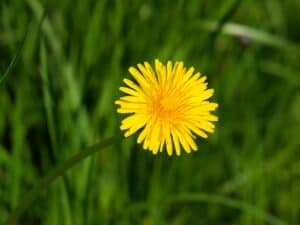
People love to blow on dandelion flowers, and they have quite a reputation as weeds, but did you know these little puffballs are edible too? Dandelions are freely available throughout the country and can be eaten from top to bottom. The leaves, flowers, and roots can all be eaten raw, but the leaves taste the best when the plant is young.
Dandelion leaves are rich in vitamins A, C, and K. Leaves and roots taste better when boiled. The roots can also be dried, roasted, and crushed to make coffee that has a mild chocolatey flavor. The flowers can be fried or made into juice.
Nettles
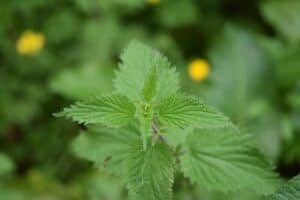
Although the stinging nettle is quite prickly and can cause itching, this plant can be used for making versatile foods like tea, beer, soup, and haggis. Once the leaves have been boiled down, the stinging hair falls off. Nettles are rich in iron vitamins and minerals; in fact, they contain more vitamin C than oranges. When choosing leaves, make sure they are young, as mature leaves can lead to kidney damage.
Wild Asparagus
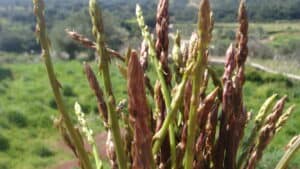
Wild asparagus is found across North America and can be found where the soil isn’t too moist. The wild variety is thinner than its cultivated counterpart. Foragers should look for old stalks three feet high. You can find newer shoots near these stalks that are good to eat.
Clover

All species of clover are edible, but the most common species foragers will find are the white clover and red clover. Some people can experience indigestion from raw clover, but it can be made into juice, or its flowers and seed pods can be crushed into flour. You can also make tea from clover.
Wild Onions
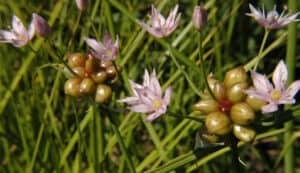
Wild onions grow along damp forest floors. All of the parts of wild onions can be eaten raw or cooked from top to bottom. Beginner foragers can recognize wild onion by its characteristic oniony smell; however, if a plant looks like an onion, but doesn’t smell like one, avoid eating it as it could be poisonous.
Bamboo

It’s not just pandas that can eat bamboo. Humans can eat them too. Bamboo belongs to a subfamily of grass and contains very high levels of fiber, potassium, and protein. The best shoots to forage are young, tender, and less than a foot tall.
Bamboo cannot be eaten raw. The outer leaves need to be peeled off, and the shoots are shaved and, sliced, and then boiled to get rid of their bitterness. It can then be eaten.
Japanese Knotweed

Japanese knotweed is native to Asia but now grows rampantly in Northeast and Midwest America. It is also sometimes known as Japanese bamboo as it has light, hollow stalks that resemble bamboo. The best time to eat the plant is when the shoots are young; at this time, they have a lemony flavor.
Japanese knotweed is a wonderful source of vitamins A and C, iodine, and the natural phenol, resveratrol. It is also known for its heart and anti-aging benefits.
Lamb’s Quarters
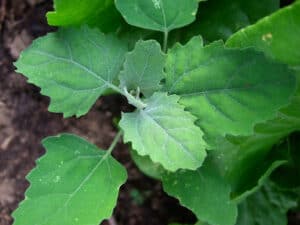
Lamb’s quarters is a tall weed with white coatings on its leaves. The leaves look like teardrops and they grow in clusters with flowers grouped tightly at the top. It is also known as wild spinach and has an earthy flavor, which some people claim tastes like chard. Lamb’s quarters are rich in protein, calcium, and vitamins A, C, and K.
The leaves can be eaten raw or cooked but in moderation due to high levels of oxalic acid.
Wild Leek

Wild leeks are a species of onion with a small bulb and wide, broad, and smooth green leaves. They can be identified by the purple or burgundy tints on their lower stems near the bulb and by their smell, which is similar to cultivated onions.
Both the bulb and leaves are edible, but they should be consumed in moderation.
Milk Thistle
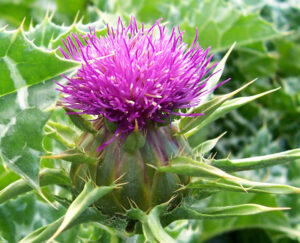
The milk thistle can be identified by its prickly light green leaves with white veins and red to purple flowers. The leaves can be eaten after the spines have been removed. Its stalk can also be boiled. Its flowers, stems, and leaves can all be eaten raw as well.
Milk thistle also has medicinal properties like aiding digestion, increasing appetite, cleansing the liver, and treating poison.
Garlic Mustard
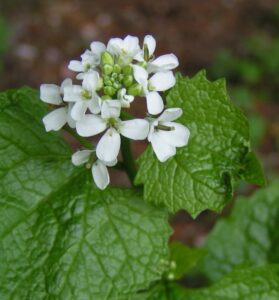
Although garlic mustard has a bad reputation in North America — it is blamed for wiping out and replacing native plants— it is a superfood for foragers. Fully mature leaves are triangular or heart-shaped with scalloped edges. When crushed, they exude a faint garlicky smell.
The flower and flower stalk can be eaten and has a spicy horseradish taste. However, the most delicious part of the plant is the young stem which tastes like a cross between a garlic scape and sugar snap peas.
Wood Sorrel

Wood sorrel and oxalis are characterized by clusters of three heart-shaped leaves that bear a strong resemblance to clover leaves. The plant comprises yellow flowers with five petals and grows in moist areas of the United States and Canada.
It is a common variety of forest undergrowth and all its parts can be safely eaten, including the flowers, stems, leaves, and seed pods. Wood sorrels have a sour, tangy taste due to the presence of oxalic acid, so chewing them can be very refreshing.
Mushrooms
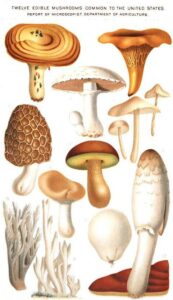
They may be our favorite pizza topping, but when you are in the wild, you have to exercise a bit more care about how you eat mushrooms.
Mushrooms are the most popular type of fungus, but they can be a predicament for foragers as some varieties can be quite toxic. If you mistake a wild poisonous mushroom for an edible one, it could very well be the last thing you ever eat.
So when you go foraging for mushrooms, you need to be positively certain that you know what you are harvesting. Even then, it is best only to test a small portion first and wait a day to make sure you don’t have any allergic reaction to the fungus.
Luckily, some of the most mouthwatering mushrooms can be easily identified. Some popular varieties are:
- Chanterelles: These mushrooms have a distinct trumpet shape like morning glories and are bright yellow-gold in color. These mushrooms are common in Eurasia, North and Central America, and Africa. They are the easiest ones to identify because of the blunt, shallow ridges on their undersides instead of the usual fine gills. However, beginner foragers may confuse them with Jack-o-Lantern mushrooms, which are poisonous but have a more orange-ish color. You can tell them apart because Jack-o-Lantern mushrooms grow in clusters with their stems attached at the base, while chanterelles grow separately.
- Morels: Morel, Morchella, or true morels, can grow in dead or dying trees, especially elm trees. They can be identified by their distinctive cone-shaped, honeycomb-patterned spongy brown cap. Beginners should not confuse them with false morels, which are of a richer red-brown shade without the honeycomb pattern and are mildly toxic. Another variety, the half-free morels, have a longer stem and attach near the top, unlike the true morels, which are attached near the bottom. Half-free morels can cause stomachaches and digestion problems in some people.
- Maitake: Maitake is a gill-less mushroom that is also called “hen of the woods” because its cap has a ruffled appearance, a bit like a roosting hen. These mushrooms are found in North America during the fall season and grow near the base of hardwood trees, especially oaks. They have a smoky, umami flavor and are popularly used in Chinese and Japanese recipes to treat hypertension and diabetes.
- Chicken of the Woods: The chicken of the woods is a different species from the hen of the woods and is also known as the sulfur shelf. These mushrooms grow in the form of large bright orange shelves with yellow undersides absent of gills and have a mild chicken-like flavor. They are found in North America, growing in clusters from the sides of hardwood trees, especially oak. Similar-looking mushrooms growing on conifer trees are a different species and are poisonous.
Berries
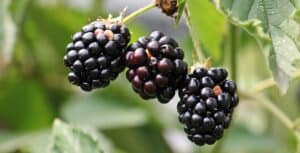
Berries are one of the easiest and most delicious types of plants to forage in the wild. They grow in abundance in many areas, and there are innumerable varieties. They are also chock-full of vitamin C and fiber and hence are the most desirable kind of edibles.
Almost all dark-colored berries are safe to eat in the wild. However, white, yellow, and unfamiliar red berries are so poisonous they can kill a person. Keep away from them unless you are sure the variety is edible.
Although grapes are not categorized as berries, all of them are generally safe to eat.
Some common berries include:
- Brambles: Species of brambles like blackberries and raspberries grow in abundance in the wilds of North America. Blackberries are found on the east and west coast, while raspberries are found almost everywhere except the Deep South. Blackberries turn from green to red and then black when they are fully ripe. Raspberries can range from red to an almost black color when ripe.
- Mulberries: Mulberries are found in eastern North America. Red mulberries have the strongest flavor, while black mulberries have a sweet flavor with almost no tartness. White mulberries taste slightly of vanilla with a tart flavor. All these mulberries are safe to eat.
- Juneberries: Also known as serviceberries, these berries are blue-purple in color and are found in the Pacific Northwest. They look and taste similar to blueberries but have larger seeds. They also have twice as much iron as blueberries.
- Wild Strawberries: Wild strawberries can be found everywhere except Hawaii. The plant consists of clusters of three jagged-edged leaves and has white flowers with yellow centers. The wild fruit looks like a smaller version of cultivated strawberries, but their fragrance and taste are much stronger. Some people confuse them with false strawberries, which point upwards on the stem rather than dangle on the vines. These strawberries can be eaten though they hardly have any flavor.
Nuts

Nuts are a great source of protein for foragers. However, take care not to overharvest from a certain place as animals and birds gather nuts for food as well. Some popular nuts that can be easily found while foraging are:
- American Groundnuts: Contrary to their name, American groundnuts are actually small tubers that are found in the wet marshlands of North America. The egg-sized tubers can be eaten like potatoes though they taste more like turnips. Although they are edible, they can cause some problems in the digestive tract.
- Acorns: Acorns, if eaten unprocessed, are extremely bitter as they contain a lot of tannins. These tannins can also damage your kidneys, so Native Americans submerged them in running streams to remove the excess. Foragers these days can ground the kernels and leach them in a jar of fresh water for three to five days, changing the water daily. You can then eat it as porridge with a mild, nutty flavor.
- Hazelnuts: The American hazelnut and the beaked hazelnut grow all throughout the forests of North America except in the Southwest. Their trees have alternating, oval, toothed leaves with long brown catkins.
Foraging for Edible Plants Safely
Foraging is an exciting activity, and beginners can easily get carried away and pick and taste every variety of plant they see. However, it is important to remember that there are about 350,000 species of plants in the world and only about 80,000 of those are edible. Take a look at some common plants that you need to steer clear of when you are foraging:
- Harlequin Glorybower: This plant is unique-looking and gorgeous, with vivid magenta calyces which surround deep blue berries. These plants are native to China, Taiwan, Korea, Japan, and India. Despite their beauty, though, handling them can cause a rash, and the seeds and other parts of the plant are poisonous.
- Mexican Poppy: The Mexican prickly poppy has beautiful light yellow flowers with spiny leaves and blooms in winter. However, it is not safe to be eaten by foragers, though it is often used in herbal medicines.
- Honeyvine: Honeyvine can be recognized by its twining vines with heart-shaped leaves, milky sap, and distinctive flowers. If consumed, it is so toxic for humans it can stop their hearts. Its sap can also cause damage to the mucous membrane and eye.
- Rattlepod: This plant has yellow flowers and pods containing seeds that make a rattling sound. This plant is poisonous to both humans and animals.
- Earth Smoke: Also known as drug fumitory, this poppy variety gets its name from the smoky-blue color of its leaves. Although the plant is used to make medicines, it is poisonous if consumed.
- Tahitian Bridal Veil: This tropical plant produces white flowers and vaguely resembles the spiderwort plant, which is safe to eat. However, it is quite poisonous to cats, dogs, and humans.
- Giant Hogweed: This huge flowering plant is extremely toxic. Its sap is phototoxic, which means contact with it prevents skin from protecting itself from the sun. As a result, foragers can suffer from severe skin inflammation, swelling, blisters, and even permanent scarring.
- Mistletoe: Although immensely popular during Christmas time, this plant has white berries, which are very poisonous. In fact, eating any part of the plant can result in nausea, vomiting, diarrhea, blurred vision, drowsiness, and seizures.
- Castor Bean: Castor beans produce castor oil. However, when the seeds are eaten raw, they can be deadly as they contain ricin. Even a few salt-grain-sized pure ricin is enough to kill a human.
- Butterweed: Although the yellow-flowered butterweed plant vaguely resembles wild mustard flowers, it is inedible as it can damage the liver. It can be differentiated from edible mustard as it does not have cruciform blossoms.
- Scarlet Sage: This plant can be identified by its square stems, brilliant red whorls of flowers growing on spikes, and a fragrance like sage. It looks similar to the edible tangerine sage; however, eating even a small amount can result in severe gastrointestinal distress.
- Unripe Mayapple: The mayapple forms colonies created from a single root. This plant has deep-cut leaves and an apple-sized fruit covered by large leaves. All parts of this plant are poisonous; however, once the green and firm fruit ripens and turns soft and yellow, you can eat the fruit.
Rules for Foraging For Edible Plants
It should be clear that foraging can be very risky if you don’t know what you are doing. Here are a few rules for foraging:
- The number one rule remains that you should never consume any plant unless you are 100 percent sure of what it is.
- Experienced foragers know not only which plants you can safely eat but how to eat them. Some species may technically be edible, but they can be very tough, unpalatable, or indigestible if you don’t know how to prepare them. Examples include acorns and bamboo, as discussed above.
- Many people can have intolerances or allergic reactions to some edible plants. It is best to learn about these medical issues beforehand. Additionally, people with medical conditions, pregnant women, or nursing mothers should avoid eating foraged plants.
- Know what time of year a plant grows or produces fruit. If you see a plant blooming out-of-season, you may be looking at an entirely different species that appear the same. It may also mean you don’t have the full information about the plant.
- Make sure that the plants you collect don’t grow in places where they can be contaminated, like near roadsides, factories, and sewerage, which makes them unsafe to eat. Also, ensure your foraged plants have not been sprayed with toxic pesticides.
- Make sure you know what endangered plants look like and avoid picking those up. It is illegal and unethical.
- Do not rip the plant out by the roots so that it has a chance to reproduce.
- Do not overharvest as animals and birds also rely on plants and weeds for their food.
- Use a knife or a pair of scissors to cleanly cut off parts of a plant so as to prevent unnecessary damage to the plant.
- Do not trespass into other people’s property to look for edible plants unless you have the landowner’s permission.
Foraging is not easy. It takes a lot of time, energy, effort and patience to learn and understand which types of plants you can safely eat and which types you should steer clear of. You would require an experienced and professional forager to teach you the rules of the game and legal access to places to forage. Because of this, a lot of people give up on the idea of foraging.
However, for others, the thrill of eating the plants that you have found, identified, picked, and prepared yourself makes all the effort worth their while!

